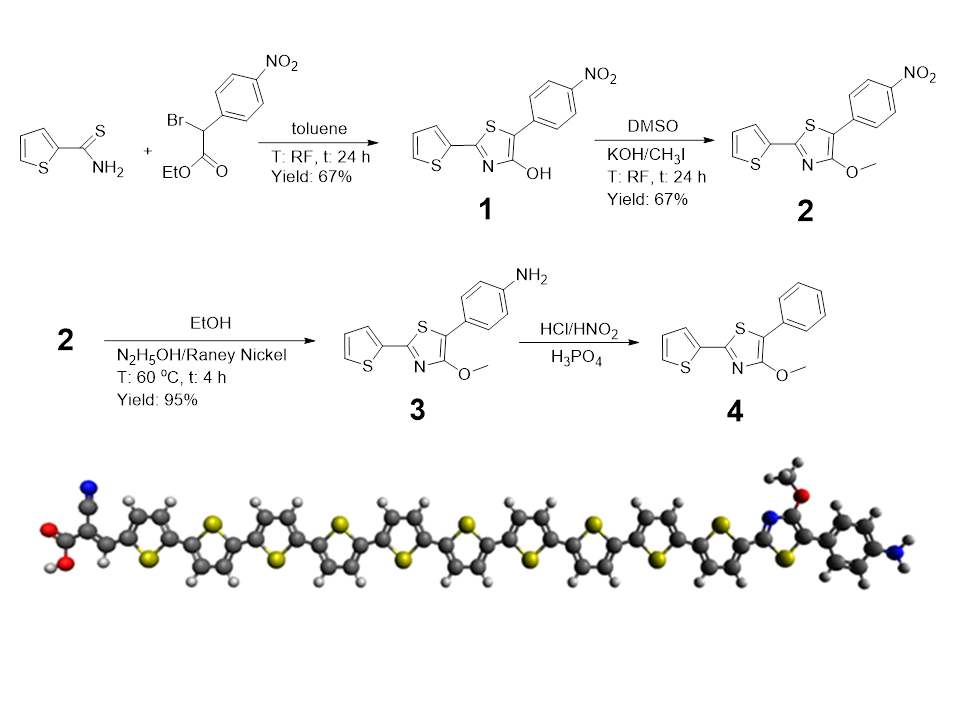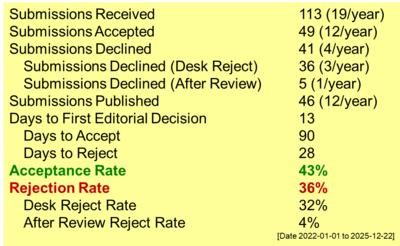Novel Absorber Material Design Based on Thiazole Derivatives Using DFT/TD-DFT Calculation Methods for High-Performance Dye Sensitized Solar Cell
DOI:
https://doi.org/10.55749/ijcs.v1i1.5Keywords:
Thiazole derivatives design, Photonic material, DFT/TD-DFT, Dye sensitized solar cellAbstract
Thiazole derivative molecules with a low energy gap have been successfully designed using the DFT/TD-DFT calculation methods. The calculations were simulated by adding varied numbers of thiophenes (1, 2, 3, and 10) and electron donating molecules of –H, -NH2, -OCH3, and –COOH in the ethanol solvent. The best thiazole derivative was the molecule constructed using a long-conjugated bridge of 10-thiophenes, the carboxyl anchoring site, and an amine addition as the electron donating molecule with an energy gap of 1.66 eV and a strong UV-Vis absorption in the red light region (673.20 nm). These designed molecules are beneficial to be applied in the equator area such as Indonesia. Further, the profound effects of the thiophene bridge in terms of the structural and energy gaps, and the variation of electron-donating molecules affected the photonic properties have been demonstrated in this paper.
References
Gasser, P. 2020. A review on energy security indices to compare country performances. Energy Policy. 139(111339). 1-17 doi: 10.1016/j.enpol.2020.111339. https://doi.org/10.1016/j.enpol.2020.111339
Ali, F., Khan, K.A., & Jahan, S. 2020. Evaluating energy security performance in Pakistan and India through aggregated energy security performance indicators (AESPI). Eur. Online J. Nat. Soc. Sci. 9(2). 425-442.
Supriadi, E., Basuki, R., Prajitno, D.H., & Mahfud, M. 2021. Produksi Biofuel Berbantuan Ultrasonik dari Minyak Kelapa Terkatalisis Ca/γ-Al2O3 dan K/γ-Al2O3. Walisongo J. Chem. 4(1). 45-56. doi: 10.21580/wjc.v4i1.7861. https://doi.org/10.21580/wjc.v4i1.7861
Morris, N., Miharjana, D., Gubbi, S., Halim, A., Prabowo, A., Napitupulu, D., & others. 2015. Sustainable Infrastructure Assistance Program: Technical Assistance for Energy RPJMN 2015-2019: Energy Sector White Paper, Asian Development Bank.
Silalahi, D.F., Blakers, A., Stocks, M., Lu, B., Cheng, C., & Hayes, L. 2021. Indonesia's Vast Solar Energy Potential. Energies. 14(17). 5424. doi: 10.3390/en14175424. https://doi.org/10.3390/en14175424
Gunawan, F.E. et al. 2022. Design and energy assessment of a new hybrid solar drying dome-Enabling Low-Cost, Independent and Smart Solar Dryer for Indonesia Agriculture 4.0, in IOP Conference Series: Earth and Environmental Science, 2022, 998(1), 12052.doi: 10.1088/1755-1315/998/1/012052. https://doi.org/10.1088/1755-1315/998/1/012052
Shiyani, T. & Bagchi, T. 2020. Hybrid nanostructures for solar-energy-conversion applications. Nanomater. Energy. 9(1). 39-46. doi: 10.1680/jnaen.19.00029. https://doi.org/10.1680/jnaen.19.00029
Gong, J., Liang, J., & Sumathy, K. 2012. Review on dye-sensitized solar cells (DSSCs): fundamental concepts and novel materials. Renew. Sustain. Energy Rev. 16(8). 5848-5860. doi: 10.1016/j.rser.2012.04.044. https://doi.org/10.1016/j.rser.2012.04.044
Devadiga, D., Selvakumar, M., Shetty, P., & Santosh, M.S. 2021. Recent progress in dye sensitized solar cell materials and photo-supercapacitors: a review. J. Power Sources. 493. 229698. doi: 10.1016/j.jpowsour.2021.229698. https://doi.org/10.1016/j.jpowsour.2021.229698
Soto-Rojo, R., Baldenebro-López, J., & Glossman-Mitnik, D. 2016. Theoretical Study of the $π$-Bridge Influence with Different Units of Thiophene and Thiazole in Coumarin Dye-Sensitized Solar Cells. Int. J. Photoenergy. 2016(6479649). doi: 10.1155/2016/6479649. https://doi.org/10.1155/2016/6479649
Kumar, R.S., Jeong, H., Jeong, J., Chitumalla, R.K., Ko, M.J., Kumar, K.S., Jang, J., & Son, Y.-A. 2016. Synthesis of porphyrin sensitizers with a thiazole group as an efficient $π$-spacer: potential application in dye-sensitized solar cells. RSC Adv. 6(47). 41294-41303. doi: 10.1039/C6RA00353B. https://doi.org/10.1039/C6RA00353B
Kooh, M.R.R., Yoong, V.N., & Ekanayake, P. 2014. Density functional theory (DFT) and time-dependent density functional theory (TDDFT) studies of selected ancient colourants as sensitizers in dye-sensitized solar cells. J. Natl. Sci. Found. Sri Lanka. 42(2). doi: 10.4038/jnsfsr.v42i2.6996. https://doi.org/10.4038/jnsfsr.v42i2.6996
Zanjanchi, F. & Beheshtian, J. 2019. Natural pigments in dye-sensitized solar cell (DSSC): a DFT-TDDFT study. J. Iran. Chem. Soc. 16(4). 795-805. doi: 10.1007/s13738-018-1561-2. https://doi.org/10.1007/s13738-018-1561-2
AL-Temimei, F.A. & Alkhayatt, A.H.O. 2020. A DFT/TD-DFT investigation on the efficiency of new dyes based on ethyl red dye as a dye-sensitized solar cell light-absorbing material. Optik (Stuttg). 208(163920). 1-7. doi: 10.1016/j.ijleo.2019.163920. https://doi.org/10.1016/j.ijleo.2019.163920
Tosco, P., Stiefl, N., & Landrum, G. 2014. Bringing the MMFF force field to the RDKit: implementation and validation. J. Cheminform. 6(1). 1-4. doi: 10.1186/s13321-014-0037-3. https://doi.org/10.1186/s13321-014-0037-3
Hernandez-Haro, N., Ortega-Castro, J., Martynov, Y.B., Nazmitdinov, R.G., & Frontera, A. 2019. DFT prediction of band gap in organic-inorganic metal halide perovskites: An exchange-correlation functional benchmark study. Chem. Phys. 516. 225-231. doi: 10.1016/j.chemphys.2018.09.023. https://doi.org/10.1016/j.chemphys.2018.09.023
Wu, Y.J. & Yang, B. V. 2011. Chapter 5.5: Five-membered ring systems: with N and S (Se). Prog. Heterocycl. Chem. 23. 685-714. doi: 10.1016/B978-0-08-096805-6.00009-7. https://doi.org/10.1016/B978-0-08-096805-6.00009-7
Gao, P., Tsao, H.N., Yi, C., Grätzel, M., & Nazeeruddin, M.K. 2014. Extended $π$-Bridge in Organic Dye-Sensitized Solar Cells: the Longer, the Better? Adv. Energy Mater. 4(7). 1301485. doi: 10.1002/aenm.201301485. https://doi.org/10.1002/aenm.201301485
Seo, K.D., Choi, I.T., Park, Y.G., Kang, S., Lee, J.Y., & Kim, H.K. 2012. Novel D-A-π-A coumarin dyes containing low band-gap chromophores for dye-sensitised solar cells. Dye. Pigment. 94(3). 469-474. doi: 10.1016/j.dyepig.2012.02.015. https://doi.org/10.1016/j.dyepig.2012.02.015
Tong, J. et al. 2021. High-performance methylammonium-free ideal-band-gap perovskite solar cells. Matter. 4(4). 1365-1376. doi: 10.1016/j.matt.2021.01.003. https://doi.org/10.1016/j.matt.2021.01.003
Krauter, C.M., Möhring, J., Buckup, T., Pernpointner, M., & Motzkus, M. 2013. Ultrafast branching in the excited state of coumarin and umbelliferone. Phys. Chem. Chem. Phys. 15(41). 17846-17861. doi: 10.1039/C3CP52719K. https://doi.org/10.1039/c3cp52719k
Pulli, E., Rozzi, E., & Bella, F. 2020. Transparent photovoltaic technologies: Current trends towards upscaling. Energy Convers. Manag. 219. 112982. doi: 10.1016/j.enconman.2020.112982. https://doi.org/10.1016/j.enconman.2020.112982

Downloads
Additional Files
Published
How to Cite
Issue
Section
License
Copyright (c) 2022 Indonesian Journal of Chemical Studies

This work is licensed under a Creative Commons Attribution-ShareAlike 4.0 International License.



















